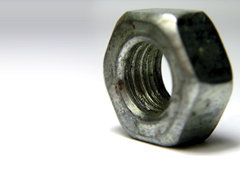Manufacturing pulls through
 Northern Ireland’s manufacturing sector has steadied and is showing signs of recovery.
Northern Ireland’s manufacturing sector has steadied and is showing signs of recovery.
Several years ago an eminent economist told a Belfast business audience that, by 2020, anything in the world that needs to be manufactured on a large scale will be “made in Asia”.
With many traditional British industries like shipbuilding, motor production and textiles already in their death throes, the inference was that lower-cost countries, particularly in the Far East, were on an inexorable path towards ensuing their handprints would be over all future wares.
But it seems the obituaries on the manufacturing sector have been premature, especially in Northern Ireland, which gave the world not only the Titanic, but world-renowned innovations of their era such as the pneumatic tyre, Ferguson tractor, portable defibrillator and vertical take-off jet.
And as many sectors contract in what is the worst economic downturn in a generation, the North’s manufacturing firms have enjoyed something of a renaissance.
Manufacturing currently accounts for 13 per cent of employment here, and in recent years global organisations such as Caterpillar, DuPont, Bombardier, BAE Systems, Schrader and Sandvik have all invested heavily in Northern Ireland.
And when Invest NI is “selling” us overseas, it invariably points to the province’s availability of a loyal, disciplined workforce, highly qualified young people, and that proud manufacturing tradition dating back to the earliest days of the Industrial Revolution.
Traditionally there have always been strong links too with both of Northern Ireland’s universities, which have tailored postgraduate and management development courses to suit the needs of manufacturers.
And around 2,000 graduates currently qualify with degrees in engineering and IT-related degrees every year, ensuring a plentiful supply of young talent for manufacturing based investors.
“The manufacturing sector is weathering the storm best, and employment levels in the sector are comparatively stable,” according to Ulster Bank economist Richard Ramsey.
“While most sectors continue to report falling output, new orders and employment levels, manufacturing remains the best performer. Indeed, manufacturing employment levels have fallen only marginally over each of the last four months, which is highly encouraging in their current climate, “ he added.
Northern Bank economist Angela McGowan goes even further, predicting that manufacturing would grow at 4 per cent in 2011. By any current measure, that is stellar.
“Manufacturing is a key part of our economy going forward and has tremendous potential for significantly increasing its value-added income from R&D and innovation,” Ms McGowan said.
The sector’s strength was further underlined when Port of Belfast, the largest trade gateway in the north and the second busiest on the island, revealed a modest recovery in trade for 2010.
Belfast Harbour Chairman Len O’Hagan said: “While issues remain over the strength of the economic recovery, particularly in the Republic of Ireland, there are reasons to be optimistic about future trends.
“With the agri-food and associated sectors continuing to expand, it also appears that manufacturing activity in Northern Ireland is beginning to show signs of increased activity and a tentative recovery.”
Challenges remain, however. Gone are the simultaneous booms in public expenditure, property and construction, employment and inward migration, particularly from eastern Europe, that helped propel the economy in the North for much of the decade before the downturn.
So too the Celtic Tiger boom that buoyed the many Northern Ireland companies selling into the South.
The Republic is Northern Ireland’s most important trading partner after Britain, accounting for 28 per cent of total manufacturing exports. Northern Ireland’s total manufacturing exports to the Republic are the same size as all other sales to Asia and the rest of the EU combined.
Indeed Northern Ireland exports seven times as many manufacturing goods to the Republic as it does to the eurozone’s largest economy, Germany.
When the Celtic Tiger was booming and one of Europe’s fastest-growing economies was right on their doorstep, expanding at a rapid pace, there was little need for businesses in the North to be overly-concerned at exploring new export markets.
Manufacturing exports to the Republic grew by almost 10 per cent on average (in real terms) in each of the six years to 2007-2008 (four times the rate of growth achieved for all other exports).
But given the collapse of the economy south of the border, the North’s closely linked market has effectively disintegrated, especially that for firms manufacturing products for the Republic’s beleaguered construction industry.
With austerity measures likely in the North once the next four-year Budget kicks in, fuelled too by increases in inflation and VAT, continuing high unemployment, wider jobs uncertainty and a likely reduction in spending, it remains to be seen if manufacturing can sustain its current upwards trajectory.
And for some manufacturers, that may mean turning their attentions to markets outside Ireland and even Britain.





